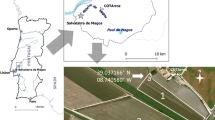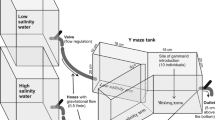Abstract
Freshwater crustaceans are known to disperse overland, aiding the invasion of new environments. To analyze the effect of environmental variables (humidity, temperature, illuminance, vegetation, and slope) on the movement direction of Eriocheir sinensis (H. Milne Edwards, 1853), Pacifastacus leniusculus (Dana, 1852) and Procambarus clarkii (Girard, 1852) in land, the animals were placed at the centre of a metal gutter and given a choice between two values of each variable. Chi-squared tests revealed significant preferences for E. sinensis to move downhill, P. leniusculus to move toward cooler areas and P. clarkii to move downhill and toward cooler areas. To test the ability of P. leniusculus and P. clarkii (E. sinensis was not present at the testing site) to return to water, they were placed in a circular arena near the river bank and their direction of movement was recorded. Chi-squared tests revealed that P. leniusculus, when isolated and in groups of 6, showed a significant tendency to move downstream, but not directly toward the water. P. clarkii showed no significant preference in movement direction. Since movement direction and overland dispersal are influenced by environmental gradients of temperature and elevation, these variables are fundamental for predicting autonomous overland dispersal and colonization patterns.




Similar content being viewed by others

References
Aquiloni, L., M. Ilhéu & F. Gherardi, 2005. Habitat use and dispersal of the invasive crayfish Procambarus clarkii in ephemeral water bodies of Portugal. Marine and Freshwater Behaviour and Physiology 38: 225–236.
Assessment, M. E., 2005. Ecosystems and Human Well-Being. Island Press, Washington, DC.
Barbaresi, S., F. Gherardi & M. Vannini, 1997. Movement patterns of river crabs (Decapoda, Potamoidea) in the field: predictable and unpredicatable components. Journal of Zoology 242: 247–259.
Bondar, C. A., Y. Zhang, J. S. Richardson & D. Jesson, 2005. The conservation status of the freshwater crayfish, Pacifastacus leniusculus, in British Columbia. Fisheries Management Report No. 117. Ministry of Water, Land and Air Protection.
Bouma, S. & D. M. Soes, 2010. A risk analysis of the Chinese mitten crab in the Netherlands. Bureau Waardenburg bv Project No. 09-772, Report No. 10-025. Ministry of Agriculture, Nature and Food Quality, Team Invasive Alien Species.
Bovbjerg, R. V., 1959. Density and dispersal in laboratory crayfish populations. Ecology 40(3): 504–506.
Capinha, C., B. Leung & P. Anastácio, 2011. Predicting worldwide invasiveness for four major problematic decapods: an evaluation of using different calibration sets. Ecography 34: 448–459.
Chucholl, C., 2011. Disjunct distribution pattern of Procambarus clarkii (Crustacea, Decapoda, Astacida, Cambaridae) in an artificial lake system in Southwestern Germany. Aquatic Invasions 6: 1–5.
Claussen, D. L., R. A. Hopper & A. M. Sanker, 2000. The effects of temperature, body size, and hydration state on the terrestrial locomotion of the crayfish Orconectes rusticus. Journal of Crustacean Biology 20: 218–223.
Cruz, M. J. & R. Rebelo, 2007. Colonization of freshwater habitats by an introduced crayfish, Procambarus clarkii, in Southwest Iberian Peninsula. Hydrobiologia 575: 191–201.
Dunham, D. & H. Schöne, 1984. Substrate slope and orientation in a land hermit crab, Coenobita clypeatus (Decapoda, Coenobitidae). Journal of Comparative Physiology A 154: 511–513.
Eshky, A., R. Atkinson & A. Taylor, 1995. Physiological ecology of crabs from Saudi Arabian mangrove. Marine Ecology Progress Series 126: 83–95.
Field, L. H., 1990. Aberrant defense displays of the big-handed crab, Heterozius rotundifrons (Brachyura: Belliidae). New Zealand Journal of Marine and Freshwater Research 24: 211–220.
Fraenkel, G. S. & D. L. Gunn, 1961. The Orientation of Animals: Kineses, Taxes and Compass Reactions. Dover, Oxford.
Gherardi, F., E. Tricarico & M. Ilhéu, 2002. Movement patterns of an invasive crayfish, Procambarus clarkii, in a temporary stream of southern Portugal. Ethology Ecology & Evolution 14: 183–197.
Grey, J. & M. C. Jackson, 2012. ‘Leaves and Eats Shoots’: direct terrestrial feeding can supplement invasive red swamp crayfish in times of need. PLoS ONE 7(8): e42575.
Grote, J., 1981. The effect of load on locomotion in crayfish. Journal of Experimental Biology 92: 277–288.
Guan, R. Z. & P. R. Wiles, 1997. Ecological impact of introduced crayfish on benthic fishes in a British lowland river. Conservation Biology 11: 641–647.
Gunn, D., 1937. The humidity reactions of the wood-louse, Porcellio scaber (Latreille). Journal of Experimental Biology 14: 178–186.
Hanson, E. & M. Sytsma, 2005. The potential for mitten crab colonization of estuaries on the west coast of North America. Pacific States Marine Fisheries Comission and Alaska Department of Fish and Game Final Report. Center for Lakes and Reservoirs, Portland State University.
Hazlett, B. A. & C. McLay, 2000. Contingencies in the behaviour of the crab Heterozius rotundifrons. Animal Behaviour 59: 965–974.
Herborg, L., D. A. Rudnick, Y. Siliang, D. M. Lodge & H. Macisaac, 2007. Predicting the range of Chinese mitten crabs in Europe. Conservation Biology 21: 1316–1323.
Hiley, P., 2003. The slow quiet invasion of signal crayfish (Pacifastacus leniusculus) in England—prospects for the white-clawed crayfish (Austropotamobius pallipes). In Holdich, D. M. & P. J. Sibley (eds), Management and Conservation of Crayfish. Proceedings of a Conference held on 7th November 2002. Environment Agency, Bristol: 127–138.
Holdich, D. M., 2002. Biology of Freshwater Crayfish. Blackwell Science, Oxford.
Huner, J. V. & J. E. Barr, 1991. Red swamp crayfish: Biology and exploitation. Louisiana Sea Grant College Program, Centre for Wetland Resources, Louisiana State University, Baton Rouge, Louisiana.
Huner, J. V. & O. V. Lindqvist, 1995. Physiological adaptations of freshwater crayfishes that permit successful aquacultural enterprises. American Zoologist 35: 12–19.
Jones, C. M. & I. M. Ruscoe, 2001. Assessment of five shelter types in the production of redclaw crayfish Cherax quadricarinatus (Decapoda: Parastacidae) under earthen pond conditions. Journal of the World Aquaculture Society 32: 41–52.
Kerby, J. L., S. P. D. Riley, L. B. Kats & P. Wilson, 2005. Barriers and flow as limiting factors in the spread of an invasive crayfish (Procambarus clarkii) in southern California streams. Biological Conservation 126(3): 402–409.
Lagerspetz, K. Y. H., 1963. Humidity reactions of three aquatic amphipods, Gammarus duebeni, G. oceanicus and Pontoporeia affinis in the air. Journal of Experimental Biology 40: 105–110.
Lagerspetz, K. Y. H., 2000. Thermal avoidance and preference in Daphnia magna. Journal of Thermal Biology 25: 405–410.
Lagerspetz, K. Y. H., 2003. Thermal acclimation without heat shock, and motor responses to a sudden temperature change in Asellus aquaticus. Journal of Thermal Biology 28: 421–427.
Lagerspetz, K. Y. H. & A. Lehtonen, 1961. Humidity reactions of some aquatic isopods in the air. Biological Bulletin 120: 38–43.
Lagerspetz, K. Y. H. & L. A. Vainio, 2006. Thermal behaviour of crustaceans. Biological Reviews 81: 237–258.
Larson, E. R., J. D. Olden & N. Usio, 2010. Decoupled conservatism of Grinnellian and Eltonian niches in an invasive arthropod. Ecosphere 1:art16 doi:10.1890/ES10-00053.1.
Lodge, D. M., R. A. Stein, K. M. Brown, A. P. Covich, C. Brönmark, J. E. Garvey & S. P. Klosiewskt, 1998. Predicting impact of freshwater exotic species on native biodiversity: challenges in spatial scaling. Australian Journal of Ecology 23: 53–67.
Lodge, D. M., C. A. Taylor, D. M. Holdich & J. Skurdal, 2000. Nonindigenous crayfishes threaten North American freshwater biodiversity: lessons from Europe. Fisheries 25: 7–20.
Lowe, S., M. Browne, S. Boudjelas & M. De Poorter, 2000. 100 of the world’s worst invasive alien species: a selection from the global invasive species database. Invasive Species Specialist Group (ISSG), a specialist group of the Species Survival Commission (SSC) of the World Conservation Union (IUCN), <www.issg.org/booklet.pdf>.
Lutz, C. & W. Wolters, 1999. Mixed model estmation of genetic and environmental correlations in red swamp crawfish Procambarus clarkii (Girard). Aquaculture Research 30: 153–163.
Panning, A., 1938. The Chinese mitten crab. Annual Report Smithsonian Institution.
Payette, A., 2003. Thermoregulatory behavior of the crayfish Procambarus clarki in a burrow environment. Comparative Biochemistry and Physiology 136: 539–556.
Peay, S., P. Hiley, P. Collen & I. Martin, 2006. Biocide treatment of ponds in Scotland to eradicate signal crayfish. Bulletin Français de la Pêche et de la Pisciculture:1363–1379.
Penn Jr, G. H., 1943. A study of the life history of the Louisiana red-crawfish. Cambarus clarkii Girard. Ecology 24(1): 1–18.
Ramalho, R., 2012. Dispersal and population regulation of the red swamp crayfish (Procambarus clarkii). PH.D. Thesis in Environmental Sciences. University of Évora: 182 pp.
Ramalho, R., W. McClain & P. Anastácio, 2010. An effective and simple method of temporarily marking crayfish. Freshwater Crayfish 17: 57–60.
Siesa, M. E., 2011. Freshwater communities and biological invasions: Odonata, Amphibia and Procambarus clarkii. PH.D. Thesis in Ricerca in Scienze Naturalistiche e Ambientali. Università degli Studi di Milano, 145 p.
Townsend, C. R. & T. A. Crowl, 1991. Fragmented population structure in a native New Zealand fish: an effect of introduced brown trout? Oikos 61: 347–354.
Tricarico, E., T. Breithaupt & F. Gherardi, 2011. Interpreting odours in hermit crabs: a comparative study. Estuarine, Coastal and Shelf Science 91: 211–215.
Vannini, M. & J. Ferretti, 1997. Chemoreception in two species of terrestrial hermit crabs (Decapoda: Coenobitidae). Journal of Crustacean Biology 17: 33–37.
Veldhuizen, T. C., 2001. Life history, distribution, and impacts of the Chinese mitten crab, Eriocheir sinensis. Aquatic Invaders 12: 1–9.
Viosca, P., 1939. Where to fish in Louisiana for crawfish. Louisiana Conservation Review. Partment of Conservation State of Louisiana, Louisiana State University.
Vitousek, P. M., C. M. D’Antonio, L. L. Loope & R. Westbrooks, 1996. Biological invasions as global environmental change. American Scientist 84: 468–478.
Warburg, M. R., 1968. Behavioral adaptations of terrestrial isopods. American Zoologist 8: 545–559.
Weinstein, R. B., 1998. Effects of temperature and water loss on terrestrial locomotor performance in land crabs: integrating laboratory and field studies. American Zoologist 38: 518–527.
Westman, K., R. Savolainen & M. Julkunen, 2002. Replacement of the native crayfish Astacus astacus by the introduced species Pacifastacus leniusculus in a small, enclosed Finnish lake: a 30-year study. Ecography 25: 53–73.
Acknowledgements
All the experiments were performed in accordance with the Portuguese legislation regarding animal experimentation and regarding the handling of exotic species. Permits to capture and handle invasive freshwater fauna were provided by Instituto da Conservação da Natureza e das Florestas (ICNF). COTARROZ allowed the capture of crayfish in its lands. F. Banha holds a PhD grant from FCT, Fundação para a Ciência e Tecnologia, (SFRH/BD/81378/2011). This research work benefited from the DID (Dispersal of Invasive Decapoda) (PTDC/BIA-BEC/105182/2008) research project co-financed by the Portuguese Fundação para a Ciência e Tecnologia (FCT), and the European Union programs COMPETE, QREN and FEDER.
Author information
Authors and Affiliations
Corresponding author
Additional information
Handling editor: Lee B. Kats
Rights and permissions
About this article
Cite this article
Marques, M., Banha, F., Águas, M. et al. Environmental cues during overland dispersal by three freshwater invaders: Eriocheir sinensis, Pacifastacus leniusculus, and Procambarus clarkii (Crustacea, Decapoda). Hydrobiologia 742, 81–93 (2015). https://doi.org/10.1007/s10750-014-1968-4
Received:
Revised:
Accepted:
Published:
Issue Date:
DOI: https://doi.org/10.1007/s10750-014-1968-4



